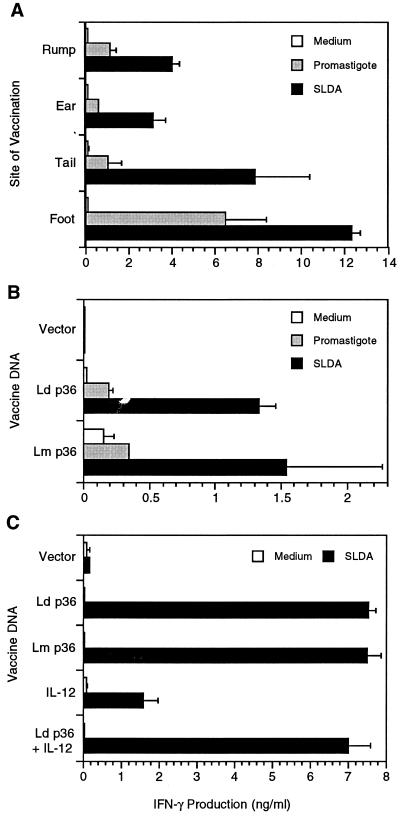FIG. 1.
Vaccination of mice with L. donovani or L. major p36(LACK) DNA induces a strong in vitro antigen-specific IFN-γ response. (A) Groups of three or four BALB/c mice were vaccinated in the skin of the rump, ear, tail, or hind footpad with 100 μg of purified L. donovani p36(LACK) plasmid DNA on days 0 and 14. On day 28 the mice were sacrificed and the spleen cells were isolated and stimulated in vitro with SLDA (25 μg/ml) or live L. donovani promastigotes (105/well). Culture supernatants were harvested after stimulation for 72 h, and the concentration of IFN-γ was determined by sandwich ELISA. The antigen-induced IFN-γ concentration in culture supernatants is shown as the mean and standard error of the mean for the stimulated (SLDA and promastigotes) and unstimulated (medium) spleen cells. Data shown are from a single immunization experiment. (B) The immunogenicities of the L. donovani (Ld) and L. major (Lm) p36(LACK) DNA vaccines was compared. Groups of three mice were immunized in the hind footpad with the p36(LACK) DNA or vector control, and the spleen cell IFN-γ response to SLDA or viable promastigotes was determined as described above. The data shown are representative of two experiments. (C) The effect of coadministration of IL-12 DNA with the p36(LACK) DNA vaccine was determined. Groups of four mice were immunized as described above with either the L. donovani (Ld) or L. major (Lm) p36(LACK) DNA vaccines, the L. donovani (Ld) p36(LACK) DNA vaccine plus IL-12 DNA (100 μg), the IL-12 DNA alone, or the vector control DNA. Spleen cells were harvested and the SLDA-induced IFN-γ response was determined as described for panel A. The data presented are representative of two experiments.

